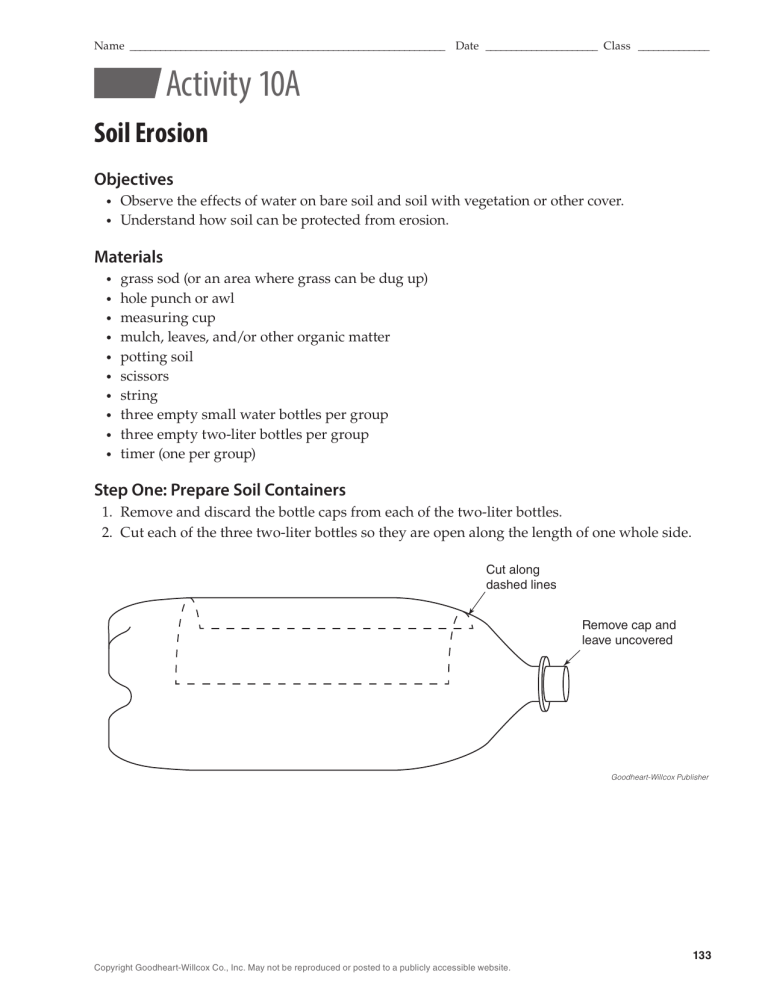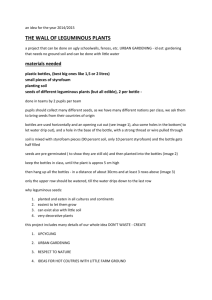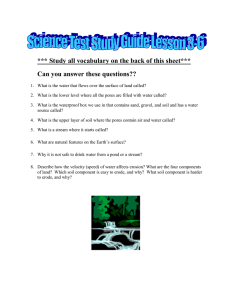
Name ______________________________________________________________ Date ______________________ Class ______________ Activity 10A Soil Erosion Objectives • • Observe the effects of water on bare soil and soil with vegetation or other cover. Understand how soil can be protected from erosion. Materials • • • • • • • • • • grass sod (or an area where grass can be dug up) hole punch or awl measuring cup mulch, leaves, and/or other organic matter potting soil scissors string three empty small water bottles per group three empty two-liter bottles per group timer (one per group) Step One: Prepare Soil Containers 1. Remove and discard the bottle caps from each of the two-liter bottles. 2. Cut each of the three two-liter bottles so they are open along the length of one whole side. Cut along dashed lines Remove cap and leave uncovered Goodheart-Willcox Publisher 133 Copyright Goodheart-Willcox Co., Inc. May not be reproduced or posted to a publicly accessible website. 134 Natural Resources Systems Lab Workbook Step Two: Fill the Soil Containers 1. Fill two of the bottles with potting soil so that the top of the soil is level with the opening at the top of the bottle. 2. Top off one of the bottles containing soil with mulch. 3. In the third bottle, pack the grass/sod with soil attached into the cut opening. 4. Place the three bottles along the edge of a desk or table with the open ends hanging over the edge. Top of soil (First and second bottles) Grass/sod with attached soil (third bottle) Goodheart-Willcox Publisher Step Three: Prepare Water Collection Devices 1. Cut and discard the top half of all three water bottles. 2. Punch a hole on one side of the bottle (near the cut line). Punch another hole directly across from the first hole. 3. Cut a 10″ piece of string and tie it securely through the punched holes. 4. Hang the water collection devices from the open ends of the two-liter bottles. String Table top Cut water bottle Goodheart-Willcox Publisher Copyright Goodheart-Willcox Co., Inc. May not be reproduced or posted to a publicly accessible website. Chapter 10 Soil Erosion, Leaching, and Pollution 135 Name ______________________________________________________________ Step Four: Conduct the Experiment 1. You will need to observe water flow in each bottle and record the data on the chart provided (following). Before pouring water into the containers, review the table to ensure you observe and record the necessary data. 2. Set your timer. 3. Activate the timer as you begin slowly pouring two cups of water into the first two-liter bottle (at the end opposite the opening). Record the data. 4. Repeat the process for each of the bottles. Time for Water to Reach Treatment Collection Device Ammount of Water in Collection Device (use measuring cup) Water Sediment Observations Grass Mulch Soil only Step Five: Replicate the Experiment 1. Empty the water collection devices. 2. Set your timer. 3. Activate the timer as you begin slowly pouring two cups of water into the first two-liter bottle (at the end opposite the opening). Record the data. 4. Repeat the process for each of the bottles. Time for Water to Reach Treatment Collection Device Ammount of Water in Collection Device (use measuring cup) Grass Mulch Soil only Copyright Goodheart-Willcox Co., Inc. May not be reproduced or posted to a publicly accessible website. Water Sediment Observations 136 Natural Resources Systems Lab Workbook Step Six: Conclusion 1. Which treatment has the most soil erosion? _____________________________________________________________________________________________________ _____________________________________________________________________________________________________ _____________________________________________________________________________________________________ _____________________________________________________________________________________________________ _____________________________________________________________________________________________________ _____________________________________________________________________________________________________ _____________________________________________________________________________________________________ _____________________________________________________________________________________________________ _____________________________________________________________________________________________________ 2. Which treatment has the least soil erosion? _____________________________________________________________________________________________________ _____________________________________________________________________________________________________ _____________________________________________________________________________________________________ _____________________________________________________________________________________________________ _____________________________________________________________________________________________________ _____________________________________________________________________________________________________ _____________________________________________________________________________________________________ _____________________________________________________________________________________________________ _____________________________________________________________________________________________________ 3. How does this lab relate to the methods farmers use to prevent soil erosion? _____________________________________________________________________________________________________ _____________________________________________________________________________________________________ _____________________________________________________________________________________________________ _____________________________________________________________________________________________________ _____________________________________________________________________________________________________ _____________________________________________________________________________________________________ _____________________________________________________________________________________________________ _____________________________________________________________________________________________________ _____________________________________________________________________________________________________ _____________________________________________________________________________________________________ _____________________________________________________________________________________________________ _____________________________________________________________________________________________________ Copyright Goodheart-Willcox Co., Inc. May not be reproduced or posted to a publicly accessible website.


